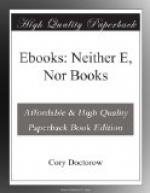There’s a temptation to view downloading a book as comparable to bringing it home from the store, but that’s the wrong metaphor. Some of the time, maybe most of the time, downloading the text of the book is like taking it off the shelf at the store and looking at the cover and reading the blurbs (with the advantage of not having to come into contact with the residual DNA and burger king left behind by everyone else who browsed the book before you). Some writers are horrified at the idea that three hundred thousand copies of my first novel were downloaded and “only” ten thousand or so were sold so far. If it were the case that for ever copy sold, thirty were taken home from the store, that would be a horrifying outcome, for sure. But look at it another way: if one out of every thirty people who glanced at the cover of my book bought it, I’d be a happy author. And I am. Those downloads cost me no more than glances at the cover in a bookstore, and the sales are healthy.
We also like to think of physical books as being inherently countable in a way that digital books aren’t (an irony, since computers are damned good at counting things!). This is important, because writers get paid on the basis of the number of copies of their books that sell, so having a good count makes a difference. And indeed, my royalty statements contain precise numbers for copies printed, shipped, returned and sold.
But that’s a false precision. When the printer does a run of a book, it always runs a few extra at the start and finish of the run to make sure that the setup is right and to account for the occasional rip, drop, or spill. The actual total number of books printed is approximately the number of books ordered, but never exactly — if you’ve ever ordered 500 wedding invitations, chances are you received 500-and-a-few back from the printer and that’s why.
And the numbers just get fuzzier from there. Copies are stolen. Copies are dropped. Shipping people get the count wrong. Some copies end up in the wrong box and go to a bookstore that didn’t order them and isn’t invoiced for them and end up on a sale table or in the trash. Some copies are returned as damaged. Some are returned as unsold. Some come back to the store the next morning accompanied by a whack of buyer’s remorse. Some go to the place where the spare sock in the dryer ends up.
The numbers on a royalty statement are actuarial, not actual. They represent a kind of best-guess approximation of the copies shipped, sold, returned and so forth. Actuarial accounting works pretty well: well enough to run the juggernaut banking, insurance, and gambling industries on. It’s good enough for divvying up the royalties paid by musical rights societies for radio airplay and live performance. And it’s good enough for counting how many copies of a book are distributed online or off.
Counts of paper books are differently precise from counts of electronic books, sure: but neither one is inherently countable.




